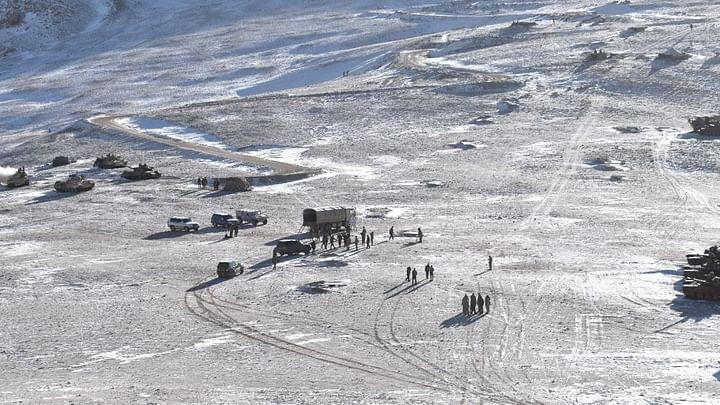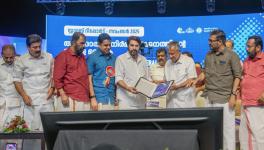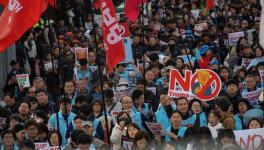Big Picture of Disengagement in Ladakh

The Ministry of External Affairs has done the right thing by explaining its taciturn press release on Thursday in a single sentence regarding the disengagement of troops in the area of Gogra-Hotsprings along the LAC in the Western Sector of India-China border areas.
The Official Spokesman Arindam Bagchi shared on Friday more details. Broadly, a consensus reached at the 16th round of India-China Corps Commander Level Meeting on 17 July has since been fleshed out by the two sides, and the actual disengagement commenced on Thursday which will be completed today. The following key elements draw attention:
- Both sides will “cease forward deployments in this area in a phased, coordinated and verified manner, resulting in the return of the troops of both sides to their respective areas.”
- All temporary structures and other allied infrastructure created in the area by both sides “will be dismantled and mutually verified.”
- “The landforms in the area will be restored to pre-stand-off period by both sides.”
- “The agreement ensures that the LAC in this area will be strictly observed and respected by both sides, and that there will be no unilateral change in status quo.”
- Going forward, the sides will “take the talks forward and resolve the remaining issues along LAC and restore peace and tranquility in India-China border areas.”
The last two elements — prohibiting “unilateral change in status quo” and the commitment to resolve the remaining issues — are, quite obviously, inter-related.
Simply put, there will be no attempts by either side to indulge in any “Mission Creep” to seize unilateral advantage of territory. This is hugely important, given the two vastly divergent narratives on what precipitated the standoff two years ago. How the “status quo” is to be understood is not yet in the public domain, but presumably, it is to mutual satisfaction.
A judicious admixture of firmness and realism (on both sides) has made this agreement possible. External Affairs Minister S Jaishankar pointedly reminded the domestic public opinion about this on September 4 even as the announcement on the disengagement four days later was being drafted jointly with China.
Only four days prior to that, on August 30, when Jaishankar said much of Asia’s future depends on how the ties between the two countries develop in the foreseeable future, and for the ties to return to a positive trajectory, they must be based on mutual sensitivity, mutual respected and mutual interest, he was clearly addressing China.
Unfortunately, some Indian commentators have rushed to belittle what has unfolded in the recent months by linking it to a possible meeting between Prime Minister Narendra Modi and Chinese President Xi Jinping next week at Samarkand. That said, if there is going to be a meeting at Samarkand, this disengagement indeed provides the setting for constructive discussion. Both governments have high stakes in maintaining peace and tranquility along the LAC in the present hugely transformative period in the world order. For China, issues of war and peace in the Taiwan Straits are a top priority.
As for India, a crucial period of adjustment to new geopolitical conditions lies ahead which presents daunting challenges to its strategic autonomy and independent foreign policies, stemming from the West’s attempts to polarise the world community against Russia and China.
Both India and China sense the high importance of pursuing their respective trajectories of economic growth and development optimally in a difficult and unfavourable climate internationally. Speaking of India, our analysts prefer — either due to ignorance or with deliberation — to sidestep the co-relation between a peaceful and tranquil border and the country’s overall economic situation.
The Ukraine conflict is adding to global inflation by raising the cost of energy and other raw commodities while an increasingly hawkish US Fed is tightening its policies, and significantly reducing its balance sheet. There could be looming currency and foreign exchange worries. Time may have come to build up a clearing system among BRICS countries. India’s current foreign exchange reserves are at their lowest since October 2020. Persistent foreign outflows from India’s equity and debt markets have also weighed on the rupee.
There is continuing Western interference in India-China relations and the fact that the government has sequestered the bilateral track with China is not going to be to the liking of the West. Fundamentally, the contradiction is that without India, there is no “Indo-Pacific Strategy” against China.
In a recent interview with an Indian newspaper, the former Prime Minister of Australia and an acclaimed hawk on China, Kevin Rudd, posed the question that troubles the Western mind most: “What does India do ultimately, if China does unilaterally resolve the border, as Gorbachev did, with the Russian Federation within the Soviet Union in 1989?”
Rudd repeated, “what would India then do in terms of China’s rise if the border was resolved, and India and China and Russia folded into one enormous market of mutual opportunity?” In such a scenario, Rudd could see only a binary choice for India: it should either “bandwagon” with China or “balance” China.
Rudd must be a terribly disappointed man to see that there could be a Third Way. China is not really expecting anyone to “bandwagon” with it. Its DNA is similar to India’s — pursuit of national interests while retaining strategic autonomy (even with regard to its partner Russia.)
China takes satisfaction that India treasures its strategic autonomy. Its expectation is only that India should not align with the US to pursue hostile policies. That is perfectly understandable, too.
A consensus with China that neither party will try to gain territorial advantage is the maximum that can be expected today and the irreducible minimum required until such time as the Indian opinion can accept a fair and just settlement of the boundary question in a spirit of compromise.
Notably, Chinese commentators have appreciated EAM Jaishankar’s forceful remarks through March-April enunciating India’s oil purchases from Russia giving primacy to national interests. Conceivably, such assertion of India’s strategic autonomy created a favourable ambience in the ongoing talks at various levels with China, leading to the disengagement in Gogra-Hotsprings. Again, the Chinese commentators were appreciative that Jaishankar brought in the tantalising concept of the Asian Century during the Q&A after his speech on “India’s Vision of the Indo-Pacific” in Thailand on August 16.
Significantly, the Chinese Foreign Ministry Spokesman reacted to the remark in positive terms three days later on August 19: “As a Chinese leader put it, “Unless China and India are developed, there will be no Asian century. No genuine Asia-Pacific century or Asian century can come until China, India and other neighbouring countries are developed.” China and India are two ancient civilizations, two major emerging economies and two neighboring countries. We have far more common interests than differences. Both sides have the wisdom and capability to help each other succeed instead of undercutting each other. We hope that the Indian side will work with China to act upon the important common understandings between our leaders, i.e. “China and India are not each other’s threats, but cooperation partners and development opportunities”, bring China-India relations back to the track of steady and sound development at an early date and safeguard the common interests of China, India and our fellow developing countries.”
China and India have many common interests in the emergent world order. Only three days ago, PM’s remarks at the Eastern Economic Forum plenary at Vladivostok signalled India’s interest to work with Russia in the Arctic (where China is also a participant) as also in the Northern Sea Route (where China too is a stakeholder).
By the way, the Russia-China Joint Statement on the International Relations Entering a New Era and the Global Sustainable Development (February 4, 2022)speaks about the two countries “consistently intensifying practical cooperation for the sustainable development of the Arctic” as well as the “development and use of Arctic routes.”
There is no empirical evidence to show that China has blocked India’s pathway in the Arctic or the Russian Far East, Southeast Asia, Central Asia or West Asia. The disengagement in Ladakh gives hope that the bilateral relations can be restored, especially in the economic sphere. There is no question that India should be vigilant about its defence and national security. But to be paranoid about it or getting entrapped in xenophobic attitudes will be wasteful and ultimately debilitating.
Get the latest reports & analysis with people's perspective on Protests, movements & deep analytical videos, discussions of the current affairs in your Telegram app. Subscribe to NewsClick's Telegram channel & get Real-Time updates on stories, as they get published on our website.
























